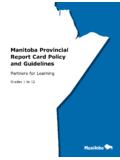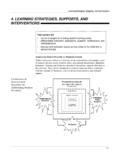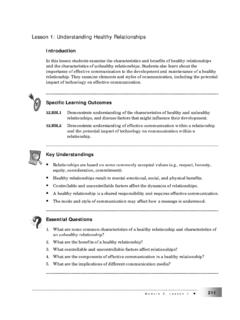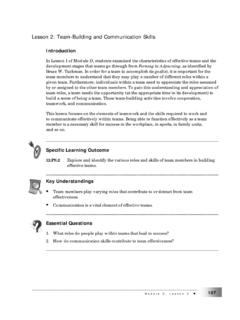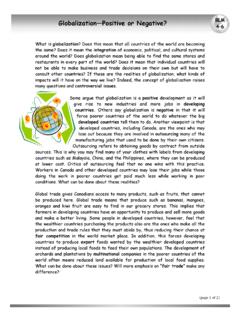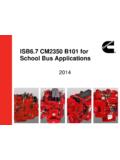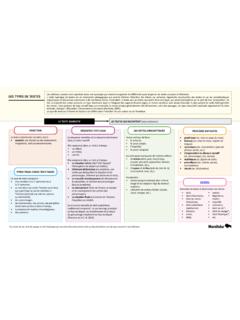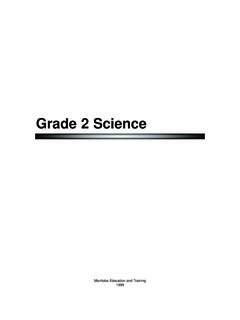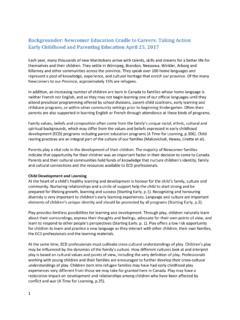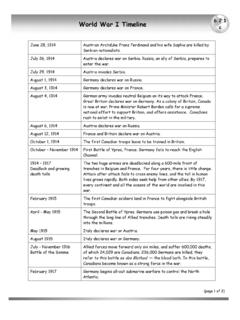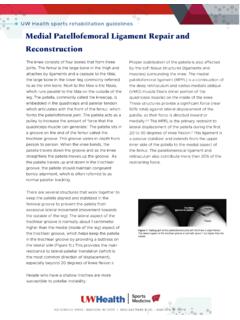Transcription of Physical Education/Health Education Movement
1 Physical Education / health EducationMovement25 MovementExplanation of the GLOA cquisition of Movement skills is a key factor for students choosing tolead physically active and healthy lifestyles. Students are less likely toparticipate in Physical activity if they have not learned the skills orexperienced success in applying them. Within the Movement GLO, thestudent will demonstrate competency in selected Movement skills,and knowledge of Movement development and Physical activitieswith respect to different types of learning experiences,environments, and different Physical activities/sports could serve as vehicles forachieving specific student learning outcomes related to Movement .
2 Forbalanced programming, however, specific student learning outcomeshave been developed for different types of learning experiences, includingsports/games, alternative pursuits, and rhythmic/gymnastic learning experiences are representative of different environmentsor settings ( , playing fields, parks, trails, recreational facilities, lakes,pools) and of multiple cultural of the SLOsThe knowledge component focusses on the basic Movement skills, Movement concepts, mechanical principles for efficient Movement , andskill development process. (See Basic Movement Skills DevelopmentalProcess Chart p. 27.) Increasing students cognitive awareness of whatthe Movement should look like, how it should be performed, or why itshould be performed in a particular way assists in motor learning and skillacquisition.
3 Highlighting the knowledge component is not meant todetract from the importance of being active, but, rather, to encouragecritical and creative thinking while participating in Physical activity. The skill component focusses on the acquisition of the basic movementskills ( , transport skills, manipulation skills, and balance abilities)across the grades, and the application of the basic Movement skills forfunctional use in a variety of Physical activities ( , sports/games,alternative pursuits, and rhythmic/gymnastic activities). The intent of allspecific student learning outcomes is to promote active participation andenable students to demonstrate functional use of the Movement skills in avariety of Physical activities that are developmentally and age-appropriate.
4 Sufficient practice time should be allocated for movementskill development. The focus is on skill acquisition, personal success,choice, inclusion, and enjoyment so students develop attitudes thatsupport lifelong participation in Physical attitude indicators relate to the general student learning outcome as awhole. Personal attitudes and values play a significant role in eachstudent s ability to enjoy, appreciate, and pursue lifelong Physical experiences need to support the development of attitudes formaking health -enhancing decisions. The attitude indicators guideteaching, learning, assessment, and anecdotal reporting across ConsiderationsA skill/theme approach is central to programming across the grades,moving from basic Movement skills in Early Years to selected and/oractivity-specific Movement skills in Middle and Senior Years.
5 See theBasic Movement Skills Developmental Process chart on page 27 basic Movement skills are the building blocks for participation in allphysical activity and are the prerequisites to many lifetime physicalactivities/sports. Physical activities/sports are the means to develop thebasic Movement skills, which may look different in the context of differentphysical activities ( , the overhand throwing pattern looks different inbaseball, football, or in a tennis serve). MovementPhysical Education / health Education26 However, the underlying principles will be similar. The basic movementskills guide teaching, learning, assessment, and reporting across ContinuumEarly Years: Basic Movement SkillsDuring Early Years (Kindergarten to Grade 4), the emphasis is on skillacquisition of the basic Movement skills with application to simpleactivities that are active and easy for children to understand.
6 Theknowledge component helps students understand what, why, and how todo the Years: Selected Movement SkillsDuring Middle Years (Grades 5 to 8), the focus is on the acquisition andapplication of selected Movement skills ( , extension, variations, orcombinations of the basic Movement skills) to lead-up-type physicalactivities. While building on the basic Movement skills through a skill-theme approach, students are expected to attain a functional use of theskill or the ability to use the skill while participating in a variety of activitiesrepresentative of different environments, settings, and/or cultures. Forexample, students can learn the basic Movement skill of striking with animplement through activities such as badminton, paddleball, baseball,floor hockey, and lacrosse.
7 The applied skill of striking is different inbadminton ( , serve, and overhead clear) from what it is in baseball( , batting, bunting). However, the underlying concepts, such aspreparatory swing, weight transfer, follow-through, and timing, aresimilar, and serve as the basis for assessing the Movement skill of knowledge component emphasizes the application of the movementconcepts and mechanical principles in game situations, aswell as activity-specific rules and procedures for safe participation in avariety of learning some grades, specific student learning outcomes emphasize particularconcepts related to specific types of games/sports to help guide teaching,learning, and assessment.
8 This approach within the Framework was takento reduce repetition from grade to grade, and to provide more directionand consistency for implementation across the province. For example,there is an emphasis on innovative games/activities in Grade 5,multicultural games in Grade 6, invasion and striking/fielding-type gamesin Grade 7, and net/wall and target games in Grade 8. This approachdoes not imply that other types of games, sports, or activities are notused as the basis for teaching, learning, and assessment strategies in eachgrade. It does suggest that the concepts and skills related to these typesof games/activities are the focus for teaching, learning, assessment, andreporting to increase opportunities for differentiation of content grade Years: Activity-Specific Movement SkillsAt Senior Years (Senior 1 to 4), students continue to acquire/apply thebasic Movement skills as activity-specific Movement skills in a variety ofphysical activities.
9 Students are provided more choice and continue todemonstrate functional use of activity-specific Movement skills for lifelongphysical activity. As well, students are guided towards using these skills inthe development and implementation of personal health fitness/physicalactivity ChartThe Summary Chart for Movement (refer to page 28) outlines thestrands, sub-strands, and attitude indicators for the GLO. It is anoverview of what a student is expected to know and be able to do in and Sequence ChartThe Scope and Sequence Chart for Movement (refer to page 29)shows grade placement of the specific student learning outcomes and thestages of learning as indicated by the icons.
10 This chart helps guideteaching, learning, and assessing across the Education / health EducationMovement27 balance SkillsMovementCategoryBody AwarenessCbody parts ( , arms, legs, elbows,knees, head)Cbody shape ( , stretched, curled,wide, narrow, twisted, symmetrical,asymmetrical) Cbody action ( , flexion, extension,rotation, swing, push, pull)Space AwarenessClocation ( , personal and generalspace)Cdirections ( , forward, backward,sideways, up, down) Clevels ( , high, middle, low)Cpathways ( , curved, straight,zigzag)Cplanes ( , frontal, horizontal,sagittal)Qualities of EffortCtime ( , fast, slow)Cforce ( , strong, light)Cflow ( , free, bound)RelationshipsCperson ( , alone, with partner, withgroup, meet, part, match, mirror,follow, lead) Capparatus ( , near, far, in, out, over,under, around, through, on, off,above, below)Cother ( , moving in relation tomusic, to the environment)TransportSkills ManipulationSkillsBasic Movement Skills Developmental Process Movement Concepts BASICMOVEMENTSKILLBIOMECHANICALPRINCIPLE SEXTENSION as applied tovarious sports, games,alternative environments,rhythmic activities of gravity andlaws of motion asthey apply tolocomotionSkills: leaping, sliding, step-hopping,rotating, dodging Suggested Activities.
